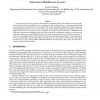SIGCOMM
2012
ACM
12 years 3 months ago
2012
ACM
As mobile devices and cellular networks become ubiquitous, first apps for popular P2P video streaming networks emerge. We have observed that when these applications operate in ce...
ICPPW
2009
IEEE
13 years 10 months ago
2009
IEEE
The JXTA-Overlay project is an effort to use JXTA technology to provide a generic set of functionalities that can be used by developers to deploy P2P applications. Since its desig...
INFOCOM
2010
IEEE
13 years 11 months ago
2010
IEEE
—The success of future P2P applications ultimately depends on whether users will contribute their bandwidth, CPU and storage resources to a larger community. In this paper, we pr...
CONCURRENCY
2008
13 years 11 months ago
2008
Very large size Peer-to-Peer systems are often required to implement efficient and scalable services, but usually they can be built only by assembling resources contributed by man...
INTERNET
2002
14 years 6 days ago
2002
Despite recent excitement generated by the peer-to-peer (P2P) paradigm and the surprisingly rapid deployment of some P2P applications, there are few quantitative evaluations of P2...
CORR
2002
Springer
14 years 10 days ago
2002
Springer
Despite recent excitement generated by the peer-to-peer (P2P) paradigm and the surprisingly rapid deployment of some P2P applications, there are few quantitative evaluations of P2...
PPNA
2008
14 years 14 days ago
2008
In both academia and industry, peer-to-peer (P2P) applications have attracted great attentions. P2P applications such as Napster, Gnutella, FastTrack, BitTorrent, Skype and PPLive,...
JASIS
2006
14 years 15 days ago
2006
P2P applications are rapidly gaining acceptance among users of Internet-based services, especially because of their capability of exchanging resources while preserving the anonymi...
CN
2010
14 years 19 days ago
2010
In the current Internet picture more than 70% of the hosts are located behind Network Address Translators (NATs). This is not a problem in the client/server paradigm. However, the...
NETWORKING
2008
14 years 1 months ago
2008
Peer-to-peer (P2P) applications are consuming a significant fraction of the total bandwidth of Internet service providers (ISPs). This has become a financial burden to ISPs and if ...






